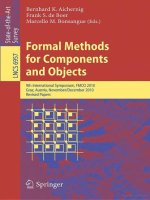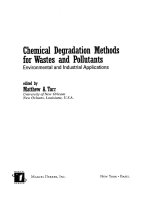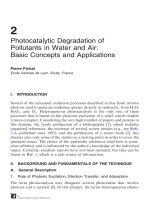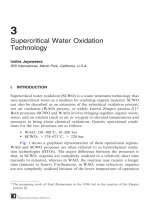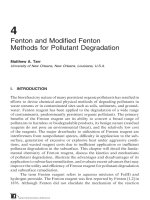Methods for modeling and verifying event driven systems= phương pháp mô hình hóa và kiểm chứng các hệ thống hướng sự kiện
Bạn đang xem bản rút gọn của tài liệu. Xem và tải ngay bản đầy đủ của tài liệu tại đây (848.91 KB, 171 trang )
Declaration of Authorship
I declare that this thesis titled, ‘Methods for modeling and verifying event-driven systems’
and the work presented in it are my own. I con rm that:
I have acknowledged all main sources of help. Where I have quoted from the work
of others, the source is always given. With the exception of such quotations, this
thesis is entirely my own work.
Where the thesis is based on work done by myself jointly with others, I have made
clear exactly what was done by others and what I have contributed myself.
This work was done wholly while in studying for a PhD degree
Signed:
Date:
i
Abstract
Modeling and veri cation plays an important role in software engineering because it
improves the reliability of software systems. Software development technologies introduce
a variety of methods or architectural styles. Each system based on a di erent architecture
is often pro-posed with di erent suitable approaches to verify its correctness. Among these
architectures, the eld of event-driven architecture is broad in both academia and industry
resulting the amount of work on modeling and veri cation of event-driven systems.
The goals of this thesis are to propose e ective methods for modeling and veri cation of
event-driven systems that react to emitted events using Event-Condition-Action (ECA)
rules and Fuzzy If-Then rules. This thesis considers the particular characteristics and the
special issues attaching with speci c types such as database and context-aware systems,
then uses Event-B and its supporting tools to analyze these systems.
First, we introduce a new method to formalize a database system including triggers by
propos-ing a set of rules for translating database elements to Event-B constructs. After the
modeling, we can formally check the data constraint preservation property and detect the
in nite loops of the system.
Second, the thesis proposes a method which employs Event-B re nement for
incrementally modeling and verifying context-aware systems which also use ECA rules to
adapt the context situation changes. Context constraints preservation are proved
automatically with the Rodin tool.
Third, the thesis works further on modeling event-driven systems whose behavior is speci
ed by Fuzzy If-Then rules. We present a re nement-based approach to modeling both
discrete and timed systems described with imprecise requirements.
Finally, we make use of Event-B re nement and existing reasoning methods to verify both
safety and eventuality properties of imprecise systems requirements.
Acknowledgements
First of all, I would like to express my sincere gratitude to my rst supervisor Assoc. Prof.
Dr. Truong Ninh Thuan and my second supervisor Assoc. Prof. Pham Bao Son for their
support and guidance. They not only teach me how to conduct research work but also
show me how to nd passion on science.
Besides my supervisors, I also would like to thank Assoc. Prof. Dr. Nguyen Viet Ha and
lecturers at Software Engineering department for their valuable comments about my
research work in each seminar.
I would like to thank Professor Shin Nakajima for his support and guidance during my
intern-ship research at National Institute of Informatics, Japan.
My sincere thanks also goes to Hanoi University of Mining and Geology and my colleges
there for their support during my PhD study.
Last but not least, I would like to thank my family: my parents, my wife, my children for
their unconditional support in every aspect. I would not complete the thesis without their
encouragement.
...
iii
Contents
Declaration of Authorship
Abstract
Acknowledgements
Table of Contents
List of Abbreviations
List of Tables
List of Figures
1
2
Introduction
1.1
1.2
1.3
1.4
1.5
Motivation . . . . . . . . . . . . . . . . . . . . . .
Objectives . . . . . . . . . . . . . . . . . . . . . .
Literature review . . . . . . . . . . . . . . . .
Contributions . . . . . . . . . . . . . . . . . . . .
Thesis structure . . . . . . . . . . . . . . . . .
Backgrounds
2.1
2.2
2.3
Temporal logic . . . . . . . . . . . . . . . . . .
Classical set theory . . . . . . . . . . . . . . .
Fuzzy sets and Fuzzy If-Then rules . .
2.3.1
2.3.2
Formal methods . . . . . . . . . . . . . . . . .
2.4.1
2.4.2
2.4.3
Event-B . . . . . . . . . . . . . . . . . . . . . . .
2.5.1
2.4
2.5
iv
Contents
2.5.2
2.5.3
2.5.4
2.5.5
2.5.6
2.6 Rodin tool . . . . . . . . . . . . . . . . .
2.7 Event-driven systems . . . . . . . .
2.7.1
2.7.2
2.7.3
2.8 Chapter conclusions . . . . . . . . .
3 Modeling and verifying database trigger systems
3.1 Introduction . . . . . . . . . . . . . . . .
3.2 Related work . . . . . . . . . . . . . .
3.3 Modeling and verifying database
3.3.1
3.3.2
3.3.3
3.4 A case study: Human resources
3.4.1
3.4.2
3.4.3
3.5 Support tool: Trigger2B . . . . . .
3.5.1
3.5.2
3.6 Chapter conclusions . . . . . . . . .
4 Modeling and verifying context-aware systems
4.1 Introduction . . . . . . . . . . . . . . . .
4.2 Related work . . . . . . . . . . . . . .
4.3 Formalizing context awareness
4.3.1
4.3.2
4.3.3
4.4 A case study: Adaptive Cruise C
4.4.1
4.4.2
4.4.3
4.4.4
4.5 Chapter conclusions . . . . . . . . .
5 Modeling and verifying imprecise system requirements
5.1 Introduction . . . . . . . . . . . . . . . .
5.2 Related work . . . . . . . . . . . . . .
Contents
5.3 Modeling fuzzy requirements . .
5.3.1
5.3.2
5.3.3
5.4 Verifying safety and eventuality p
5.4.1
5.4.2
5.4.3
5.4.4
5.5 A case study: Container Crane C
5.5.1
5.5.2
5.5.3
5.6 Chapter conclusions . . . . . . . . .
6 Conclusions
6.1 Achievements . . . . . . . . . . . . . .
6.2 Limitations . . . . . . . . . . . . . . . .
6.3 Future work . . . . . . . . . . . . . . . .
List of Publications
Bibliography
A
Event-B speci cation of Trigger example
A.1
Context speci cation of Trigger exam
A.2
Machine speci cation of Trigger exam
B
Event-B speci cation of the ACC system
B.1
Context speci cation of ACC system
B.2
Machine speci cation of ACC system
B.3
Extended context . . . . . . . . . . . . . . .
B.4
Re ned machine . . . . . . . . . . . . . . . .
C
Event-B speci cations and proof obligations of Crane Controller Example
C.1
Context speci cation of Crane Contro
C.2
Extended context . . . . . . . . . . . . . . .
C.3
Machine speci cation of Crane Contro
C.4
Re ned machine . . . . . . . . . . . . . . . .
C.5
Proof obligations for checking the saf
Contents
C.6 Proof obligations for checking convergence properties . . . . . . . . . .
List of Abbreviations
DDL
Data Da nition Language
DML
Data Manipulation Language
PO
Proof Obligation
LTL
Linear Temporal Logic
SCR
Software Cost Reduction
ECA
Event Condition Action
VDM
Vienna Development Method
VDM-SL
Vienna Development Method - Speci cation Language
FM
Formal Method
PTL
Propositional Temporal Logic
CTL
Computational Temporal Logic
SCR
Software Cost Reduction
AMN
Abstract Machine Notation
viii
List of Tables
2.1
2.2
2.3
2.4
2.5
2.6
2.7
2.8
Truth tables for propositional operators . . . . . . . . . . . .
Meaning of temporal operators . . . . . . . . . . . . . . . . .
Truth table of implication operator . . . . . . . . . . . . . . .
Comparison of B, Z and VDM [1] . . . . . . . . . . . . . . . .
Relations and functions in Event-B . . . . . . . . . . . . . .
INV proof obligation . . . . . . . . . . . . . . . . . . . . . . . . . .
VAR PO with numeric variant . . . . . . . . . . . . . . . . . . .
VAR PO with nite set variant . . . . . . . . . . . . . . . . . . .
3.1
3.2
3.3
3.4
3.5
3.6
Translation rules between database and Event-B . . . .
Formalizing a trigger . . . . . . . . . . . . . . . . . . . . . . . . . .
Encoding trigger actions . . . . . . . . . . . . . . . . . . . . . . .
Table EMPLOYEES and BONUS . . . . . . . . . . . . . . . .
INV PO of event trigger1. . . . . . . . . . . . . . . . . . . . . . .
In nite loop proof obligation of event trigger1 . . . . . . .
4.1
4.2
4.3
Modeling a context rule by an Event-B Event . . . . . .
Transformation between context-aware systems and E
Proof of context constraint preservation . . . . . . . . . . .
5.1
5.2
5.3
INV PO of event evt4 . . . . . . . . . . . . . . . . . . . . . . . . .
Deadlock free PO of machine Crane
VAR PO of event evt4 . . . . . . . . . . . . . . . . . . . . . . . . .
C.1
C.2
C.3
C.4
C.5
C.6
C.7
C.8
C.9
C.10
C.11
C.12
INV PO of event evt1 . . . . . . . . . . . . . . . . . . . . . . . . .
INV PO of event evt2 . . . . . . . . . . . . . . . . . . . . . . . . .
INV PO of event evt3 . . . . . . . . . . . . . . . . . . . . . . . . .
INV PO of event evt5 . . . . . . . . . . . . . . . . . . . . . . . . .
VAR PO of event evt1 . . . . . . . . . . . . . . . . . . . . . . . . .
NAT PO of event evt1 . . . . . . . . . . . . . . . . . . . . . . . . .
VAR PO of event evt2 . . . . . . . . . . . . . . . . . . . . . . . . .
NAT PO of event evt2 . . . . . . . . . . . . . . . . . . . . . . . . .
VAR PO of event evt3 . . . . . . . . . . . . . . . . . . . . . . . . .
NAT PO of event evt3 . . . . . . . . . . . . . . . . . . . . . . . . .
VAR PO of event evt5 . . . . . . . . . . . . . . . . . . . . . . . . .
NAT PO of event evt5 . . . . . . . . . . . . . . . . . . . . . . . . .
ix
List of Figures
1.1 Types of event-driven systems . . . . . . . . . . . . . . . . . . . . . .
1.2 Thesis structure . . . . . . . . . . . . . . . . . . . . . . . . . . . . . . .
2.1
2.2
2.3
2.4
2.5
2.6
2.7
2.8
Basic structure of an Event B model . . . . . . . . . . . . . . . . .
An Event-B context example . . . . . . . . . . . . . . . . . . . . . . .
Forms of Event-B Events . . . . . . . . . . . . . . . . . . . . . . . . . .
Event-B re nement . . . . . . . . . . . . . . . . . . . . . . . . . . . . .
Event re nement in Event-B . . . . . . . . . . . . . . . . . . . . . . . .
A convergent event . . . . . . . . . . . . . . . . . . . . . . . . . . . . .
The Rodin tool . . . . . . . . . . . . . . . . . . . . . . . . . . . . . . .
A layered conceptual framework for context-aware systems
3.1
3.2
3.3
3.4
3.5
3.6
3.7
Partial Event-B speci cation for a database system . . . . . .
A part of Event-B Context . . . . . . . . . . . . . . . . . . . . . . . .
A part of Event-B machine . . . . . . . . . . . . . . . . . . . . . . . .
Encoding trigger . . . . . . . . . . . . . . . . . . . . . . . . . . . . . .
Architecture of Trigger2B tool . . . . . . . . . . . . . . . . . . . . . .
A partial parsed tree syntax of a general trigger . . . . . . . . .
The modeling result of the scenario generated by Trigger2B
4.1
4.2
4.3
4.4
4.5
4.6
A simple context-aware system . . . . . . . . . . . . . . . . . . . . .
Incremental modeling using re nement . . . . . . . . . . . . . . .
Abstract Event-B model for ACC system . . . . . . . . . . . . . .
Events with strengthened guards . . . . . . . . . . . . . . . . . . . .
Re ned Event-B model for ACC system . . . . . . . . . . . . . . .
Checking properties in Rodin . . . . . . . . . . . . . . . . . . . . . . .
5.1
5.2
5.3
5.4
5.5
A part of Event-B speci cation for discrete transitions mode
A part of Event-B speci cation for continuous transitions mo
A part of Event-B speci cation for eventuality property mode
Container Crane Control system . . . . . . . . . . . . . . . . . . . . .
Safety properties are ensured in the Rodin tool automatical
x
Chapter 1
Introduction
1.1
Motivation
Nowadays, software systems become more complex and can be
used to integrate with other systems. Software engineers need to
understand as much as possible what they are developing. Modeling
is one of e ective ways to handle the complexity of software
development that allows to design and assess the system
requirements. Modeling not only represents the content visually but
also provides textual content. There are sev-eral types of modeling
language including graphical, textual, algebraic languages.
In software systems, errors may cause many damages for not only economics but also human beings, especially those applications in embedded systems, transportation control and health service equipment, etc.
The error usually occurs when the system execution cannot satisfy the
characteristics and constraints of the software system speci cation. The
speci cation is the description of the required functionality and behavior of
the software. Therefore, ensuring the correctness of software systems
1
Chapter 1. Introduction
has always been a challenge of software development process and reliability plays an important role deciding the success of a software project.
Testing techniques are used in normal development in order to check
whether the software execution satis es users requirements. However,
testing is an incomplete validation because it can only identi es errors
but can not ensure that the software execution is correct in all cases.
Software veri cation is one of powerful methods to nd or mathemati-cally
prove the absent of software errors. Several techniques and methods
have been proposed for software veri cation such as model-checking [3],
theorem-proving [4] and program analysis [5]. Among these techniques,
theorem proving has distinct advantages such as superior size of the system and its ability to reason inductively. Though, theorem proving often
generates a lot of proofs which are complex to understand. Veri cation
techniques mainly can be classi ed into two kinds: model-level and implementation level. Early veri cation of model speci cations helps to
reduce the cost of software construction. For this reason, modeling and
veri cation of software systems are an emerging research topic in around
the world. Many approaches and techniques of modeling and veri cation
have been proposed so far. Each of them usually focuses on a typical
kind of software architecture or design styles.
In a traditional system, one component provides a collection of proce-dures
and functions via its interfaces. Components then interact with each other by
explicitly invoking those routines. Event-driven architec-ture is one of the
most popular architectures in software project develop-ment providing
implicit invocation instead of invoking routines directly. Each component of
an event-driven system can produce events, the sys-tem then invoke all
procedures which are registered with these events. An
Chapter 1. Introduction
event-driven system consists of three essential parts: monitoring
compo-nent, transmission component and responsive one. Since
such systems work by raising and responding to events, it looses
coupling between software components and improves the interactive
capabilities with its environment. The event-driven architectural style
is becoming an essen-tial part of large-scale distributed systems
design and many applications. It is a promising architecture to
develop and model loosely coupled sys-tems and its advantages
have been recognized in both academia and industry.
There are many types of event-driven systems including many editors
where user interface events signify editing commands, rule-based production systems where a condition becoming true causes an action to be
triggered and active objects where changing a value of an object’s
attribute triggers some actions (e.g. database trigger systems) [6]. Fig-ure
1.1 shows the hierarchy of listed event-driven systems. In this thesis, we
consider two applications of active objects and rule-based production
systems: database systems with triggers and context-aware systems.
Event−driven systems
Graphic user interfacesRule−based production systems
Context−aware systems
Figure 1.1: Types of event-driven systems
In event-driven systems, Event-Condition-Action (ECA) rules are proposed as a declarative approach to specify relations when certain events
occur at prede ned conditions. An ECA rule has the form: On Event
Chapter 1. Introduction
IF conditions DO actions that means when Events occurs, if conditions
holds, then actions is performed. We also can informally represent it by ifthen rules such as if Events occurs and condition holds, then perform
action. The advantages of this approach have been applied and incor-
porated in various application domains such as active database systems,
context-aware applications. There are a huge amount of studies working
on analysing event-driven systems as well as formalizing ECA rules.
Researchers have proposed many approaches to modeling and verifying
both centralized and distributed event-driven systems with model checking techniques, which are based on temporal logic and computational
logic. Madl [7] presented an approach that de nes a speci cation of a
formal semantic domain and proposed a model-checking method to verify distributed real-time embedded systems based on timed-automata.
Joanne Atlee and John Gannon [8] focused on formalizing event-driven
system requirements based on computational tree logic (CTL). I. Ray and
P.Annmann [9] proposed to use the B-Toolkit to detect safety viola-tions
in an example of software cost reduction (SCR) speci cation. Fiege et al.
[10] presented a formal speci cation of scopes and event mappings within
a trace-based formalism adapted from temporal logic. Tran and Zdun [11]
introduced formal speci cation of the event actors-based con-structs and
the graphical notations based on Petri nets in order to enable formal
analysis of such constructs. Calder and Savegnani [12] employed a
universal process algebra that encapsulates both dynamic and spa-tial
behaviour to extend and introduce a basic formalism of bi-graphical
reactive systems.
These approaches have been proposed to modeling and verifying general
even-driven systems. In fact, engineers often develop particular types of
event-driven systems which use ECA rules to react to raised events, e.g.,
active databases and context-aware systems. In this case, these
Chapter 1. Introduction
general approaches are insu cient. Furthermore, almost existing
work of software veri cation focuses on analysing precise
descriptions of the system’s functionalities and behavior. There are a
few of methods for verifying event-driven systems which are
described by vague, uncertain or imprecise requirements.
For these reasons, new suitable methods for modeling and verifying
such systems are desirable. Moreover, if we can verify signi cant
properties of the system at early stage of design time, it will reduce
cost of the system development. It is also bene cial if they reduce the
complexity of prov-ing and is practical in software development. The
thesis proposes new methods to achieve that desire by using Event-B
formal method [13]. It is an evolution of the B formalism [14] which was
developed more than ten years ago and which has been applied in the
number of indus-trial projects. Many researchers and research groups
around the world have been inspired by system modeling and veri
cation with Event-B. Hundreds of publications relating to Event-B have
been published since 2004 [15]. Event-B notations are based on set
theory, generalized substi-tutions and the rst order logic. It is more
suitable for developing large reactive and distributed systems.
Software development in Event-B be-gins by abstractly specifying the
requirements of the whole system, then re nes them through several
steps to reach a description of the system in such a detail that can be
translated into code. The consistency of each model and the
relationship between an abstract model and its re ne-ments are
obtained by formal proofs. Support tools have been provided for EventB speci cation and proof in the Rodin platform [16]. Hence, Event-B is
totally matched for modeling and verifying event-driven sys-tems.
Chapter 1. Introduction
1.2
Objectives
The thesis aims to provide new and e ective approaches in comparison
with the existing work. Instead of working on analysing a general eventdriven system or proposing any new formal language of ECA, we focus
on modeling and verifying speci c domain applications of the event-driven
architecture such as database systems and context-aware systems using
Event-B. The thesis objective is proposing methods that not only model
the behavior of these systems which are described by If-Then rules (ECA
rules) but also formalize signi cant properties by Event-B constructs. The
correctness of these properties are proved mathematically by proving the
Event-B generated proof obligations. The Rodin tool is used for
supporting modeling and veri cation process to reduce the complexity
with automatic proving.
The thesis directs at providing tools, which support for automatic
trans-lation from an application of event-driven systems to a target
Event-B model that makes less e ort and reduces the di culties in
modeling pro-cess. The output of these tools are expected to be
able usable in the Event-B supporting tools such as Rodin.
The thesis has another objective to analyse event-driven systems
whose behavior is described by imprecise requirements. These
requirements are represented by Fuzzy If-Then rules. The thesis
introduces a new re nement-based method for modeling imprecise
requirements and veri-fying the signi cant properties such as safety
and eventuality properties of such systems.
Chapter 1. Introduction
1.3
Literature review
Joanne Atlee and John Gannon [8] presented an approach to checking
event driven systems using model checking. They introduced a technique to transforming event-oriented system requirements into statebased structures, then used a state-based checker to analyse. This
method can detect violations of systems invariants. However, it is general approach therefore if we want to apply in a speci c domain the one
is not easy to follow. Moreover, it is ine cient when requiring
intermediate steps to translate requirement into CTL machines.
Similarly, Ray I. and Ammann P. [9] also checked safety properties of
event-driven systems using B-Toolkit [17]. Even though this method
can translates SRC requirements to an Abstract machine notations
(AMN) machine [14] directly, it is still too abstract to apply in a speci c
domain and has several limitations such as requiring developers to
understand SCR and target B model contains only single class.
Prashanth, C.M. [18] described an e cient method to detect safety
spec-i
cation
violations
in
dynamic
behavior
model
of
concurrent/reactive systems. The dynamic behavior of each concurrent
object in a reactive system is assumed to be represented using UML
(Uni ed Modeling Lan-guage) state chart diagram. The veri cation
process involves building a global state space graph from these
independent state chart diagrams and traversal of large number of
states in global state space graph for detecting a safety violation.
Jalili, S. and Mirzaaghaei, M. [19] proposed to use event-based real-time
logic (ERL) as a speci cation language in order to simply specify safety
properties. By applying aspect-oriented approach to instrumentation, we
can integrate runtime veri cation module (i.e. Monitor) with program
Chapter 1. Introduction
itself and minimize overhead of runtime veri cation too. The method,
called RVERL, consists of three phases. First, safety properties are
ex-tracted from program requirements speci cation. Second,
properties are mapped to timing, functional and deadline aspects
which constitute the monitor. Then it is weaved to the program
source code. Third, at the execution time, the monitor observes
program behavior and prevent it from property violations.
Amorim Marcelo and Havelund Klaus [20] introduced the temporal logic
HAWK, a programming-oriented extension of the rule-based EAGLE
logic, and its supporting tool for runtime veri cation of Java programs. A
monitor for a HAWK formula checks if a nite trace of program events satis
es the formula. It has been shown capable of de ning and imple-menting
a range of nite trace monitoring logics, including future and past time
temporal logic, metric (real-time) temporal logics, interval logics, forms of
quanti ed temporal logics, extended regular expressions, state machines,
and others. Monitoring is achieved on a state-by-state basis avoiding any
need to store the input trace. HAWK extends EA-GLE with constructs for
capturing parameterized program events such as method calls and
method returns.
Tran and Zeduh [11] introduced formal speci cation of the event actorsbased constructs and the graphical notations based on Petri nets in order
to enable formal analysis of such constructs. Based on this, an automated translation from event actors based constructs to Petri nets using
template-based model transformation techniques is also developed.
Feideiro et al. [21] proposed a mathematical semantics for event-based
ar-chitectures to characterize the modularization properties and to further
validate and extend the categorical approach to architectural modeling.
Chapter 1. Introduction
Posse E. et al. [22, 23] proposed a language for modeling, analysis
and simulation of time-sensitive, event-driven systems. It is a language
from an informal perspective and discuss its implementation based on
event-scheduling and time-warp for distributed simulation.
Calder M. et al. [12] employ a universal process algebra that encapsulates both dynamic and spatial behaviour to extend and introduce a
basic formalism of bi-graphical reactive systems. They presented a case
study involving wireless home network management and the automatic
generation of bi-graphical models, and their analysis in real-time.
Baouab Aymen et al. [24] proposed new components, to be
deployed along the boundaries of each participating organization, o
ering exter-nal ow control, and noti cation in case of violation
detection, while providing process execution traceability. Then they
proposed an event-based approach in which inter-organizational
exchanges are perceived as events and de ne event patterns for
ltering the desirable incoming and outgoing messages.
These approaches and methods can be classi ed into two categories:
model-level veri cation and implementation-level veri cation. In this thesis,
we focus on the latter because it helps to detect errors in early design
phase. With the listed model-level veri cation methods, the com-mon
problems are that they are too general to apply in speci c domains.
The research results relating to modeling and verifying the speci c
types event-driven systems are discussed in detail in Chapter 3,
Chapter 4, and Chapter 5.
Chapter 1. Introduction
1.4
Contributions
Research contributions of this thesis are as follows.
1.
This thesis introduces a new method to model and verify a database
trigger system using Event-B. This approach provides detailed steps
to translate database concepts to Event-B notations. The transla-tion
is based on the similarity between triggers which has the form of
ECA rules and Event-B events. The method reduces cost of development because it can detect errors at early design phase and it
is easy to apply in practice. A tool partly supports for transforming a
database system with triggers is also developed.
2.
The thesis continues investigating the bene t of similar acts between
ECA rules and Event-B events to propose a method to model and
verify context-aware systems. Furthermore, the thesis recognizes
the advantages of Event-B re nement mechanism to make the proposed method suitable for incremental modeling. Signi cant properties, e.g., context constraints, are de ned as invariants and can be
checked automatically using the supporting tool Rodin.
3. We consider a system, which is described by imprecise requirements.
Its behavior rules are now speci ed in the form of Fuzzy If-Then rules.
The thesis introduces a new representation of fuzzy terms by classical
sets and present a set of rules to translate Fuzzy If-Then rules to
Event-B constructs. We also make an extension by introducing timed
Fuzzy If-Then rules to model a timed system. The thesis makes use of
Event-B re nement and the proposed modeling method to analyse
some signi cant properties of imprecise system requirements such as
safety and eventuality properties.
Chapter 1. Introduction
1.5
Thesis structure
The remainder of this thesis is organized as follows.
Chapter 2 provides necessary backgrounds for the thesis. Firstly, we
brie y introduce about temporal logic, fuzzy sets and fuzzy If-Then
rules. Next, an overview of formal veri cation and some formal
methods such as VDM, Z and B is introduced. Event-B method and its
supporting tool RODIN then is discussed in more detail. An overview of
event-driven systems and their applications such as relational
database systems and context-aware systems are also given.
Next, Chapter 3 shows how a database system including triggers can be
modeled and veri ed using Event-B. We propose a new method with a set
of translation rules to translate database components to Event-B
notations. The method ensures the correctness of data constraint preservation and enables us to discover in nite loops of the trigger execution. A
tool which partly supports for the modeling process is also developed.
We focus on modeling and verifying context-aware systems which
use context rules reacts to context changes in Chapter 4. A set of
transla-tion rules for mapping context-aware components and EventB are pre-sented. It is a re nement-based method that allows to
model the system gradually. After modeling, safety properties of
these systems are proved formally.
In Chapter 5, we consider the case that an event-driven system is described with imprecise requirements, i.e., its behavior can be described
by Fuzzy If-Then rules. We propose a new representation of fuzzy terms
in classical sets and a re nement-based method to model both discrete
and continuous behavior of the system. We also present a new method
which makes use of Event-B re nement and existing methods to verify
Chapter 1. Introduction
safety and eventuality properties of imprecise system
requirements. We show that the veri cation is mostly conducted
automatically using the current RODIN tool.
Finally, Chapter 6 discusses contributions and limitations of the
thesis. It concludes and outlines the future research direction of
the thesis. The organization of the thesis is illustrated in Figure
1.2.
Backgrounds
(Chapter 2)
Modeling and verifying database triggers
systems
Modeling and verifying context−aware
systems
(Chapter 3)
(Chapter 4)
Two types of event−driven systems with precise requirements
using ECA
structure
Modeling and verifying imprecise systems requirements
(Chapter 5)
Event−driven systems with imprecise requirements described by Fuzzy If−Then rules
Conclusions
(Chapter 6)
Figure 1.2: Thesis structure
Chapter 2
Backgrounds
In this chapter, we provide the related background knowledge for the
thesis. We rst give a brief introduction of mathematical knowledge
and logic such as classical set theory, fuzzy sets and temporal logic.
After that, before presenting Event-B formal method in detail, an
overview of VDM and its two ancestor formal methods such as Z
and B is also given. Finally, we introduce the background of eventdriven architecture and its application in two domains such as
database and context-aware computing.
2.1
Temporal logic
In classical propositional logic, a proposition is evaluated to either true (>)
or false (?) A propositional formula is a syntactic expression built from a set
of atomic predicates also sometimes known as atomic propositions,
boolean variables, or simply predicates which we denote by lower case
letters: p, q, etc. The most simple propositional formula is an expression
known as an atom which merely consists of a single atomic predicate.
13
Chapter 2. Backgrounds
More complex formulas are then built from atoms using the
connectives such as conjunction (^) , disjunction (_), negation (:),
implication ()), equivalence (,). Table 2.1 de nes the meaning of the
propositional logic operators.
Table 2.1: Truth tables for propositional operators
^
?
>
?
?
A serious disadvantage of propositional logic is that it cannot be used to
describe the time-dependent behavior of the system [25]. Propositional
temporal logic (PTL) extends the descriptive power of propositional logic
to describe a sequence of states in di erent moments of time called time
instants. We assume that there is one designated time instant
represent-ing the present. Each time instant is followed by exactly one
next time instant. The truth of a temporal formula is determined by the
truth values of its atomic propositions which may vary from time instant
to time instant. The basic element of temporal logic language is a state
formula P, which is any rst-order logic formula. It is built from atomic
predicates; the quanti ers 9, 8; the logical operators ^, _ ,:; and the
\temporal" operators (\always"), (\eventually"), and (\next"), U (\until"),
W(\weak until"), R(\release").
Linear temporal logic (LTL) is propositional temporal logic whose
inter-pretations are limited to transitions which are discrete, re exive,
tran-sitive, linear and total [26]. Linear-time temporal logic (LTL) has
the following syntax given in Backus Naur form (Equation 2.1) [27]:
::== > j?j p j (:)
(
)j(
j( _)j( ^)j( ))j
)j(
)j(U)j(W)j(R)
Chapter 2. Backgrounds
where is a formula and p is any propositional atom.
(2.1)
Let be a non-empty sequence of states, i.e. = s 0,...,sn where si is a
state. A state that satis es a state predicate P is called P-state. Let
assume that P, P1, P2 are state predicates, temporal operators can be
interpreted in Table 2.2.
Operator
P
P
P
P1UP2
2.2
Classical set theory
Sets are fundamental concepts that can be used to de ne all other concepts in mathematics. The language of set theory is based on a single
fundamental relation, called membership. a is said to be a member of
B
(denoted by a 2 B), it means that B contains a as an element. A set
which has no element is called an empty set or null set. An empty set is
denoted by the symbol ? or fg. We recall some basic constructs of set
theory as follows:
Set comprehension. Given any non-empty set s, we can de ne a new
set by considering only those elements of s that satisfy some property
p, i.e. fx 2 s j pg.
Example: a set of person who owns a red car and has a address is
expressed by fx 2 Person j redcar(x ); address(x )g.
Chapter 2. Backgrounds
Power set: If A is a set, then the set of all subsets of A is called the
power set of A, denoted by P(A).
Example: Let A be a set fx ; yg, P(A) = f?; fx g; fyg; fx ; ygg.
Ordered pair: Given two sets A and B, one of the basic constructions
of set theory is the formation of an ordered pair, ha; bi, where a 2 A
and b 2 B. The main property of ordered pairs is that if ha 1; b1i and
ha2; b2i are ordered pairs, where a1; a2 2 A and b1; b2 2 B, then ha1;
b1i = ha2; b2i i a1 = a2 and b1 = b2.
Cartesian product: Given two sets A and B, the set of all ordered pairs
ha; bi, with a 2 A and b 2 B, is a set denoted A B and called the
Cartesian product of A and B.
Relation: Given two sets A and B, a binary relation R between A and
B
is any set of ordered pairs from A B, i.e., R A B.
The domain of the relation R is denoted by dom(R) such that dom(R)
= fa 2 A j 9 b 2 B; ha; bi 2 Rg.
The range of the relation R is denoted by ran(R) such that ran(R) = fb
2 B j 9 a 2 A; ha; bi 2 Rg.
The relation R is functional if 8 a 2 A and 8 b 1; b2 2 B, if ha; b1i and
ha; b2i, then b1 = b2.
Partial function: A partial function f from a set A to a set B, denoted
by f : A 7!B is a relation that does not contain two distinct pairs with
the same rst element. If dom(f ) = A then f is a total function.
Example: If the set of all people is Person, and the set of all locations is
Location. We want to know the location of a person, then the information
may be described by a relation r Person Location. Moreover, at
Chapter 2. Backgrounds
one time, a person can only at a place. Hence, it can be described by
a partial function where : Person 7!Location.
2.3
Fuzzy sets and Fuzzy If-Then rules


